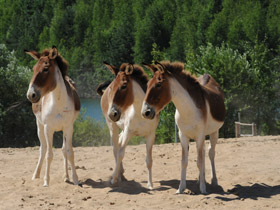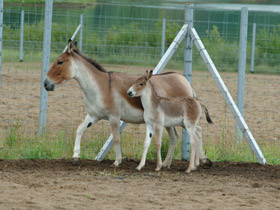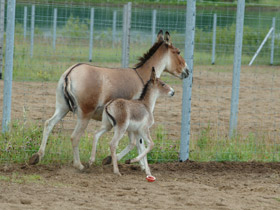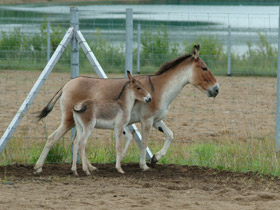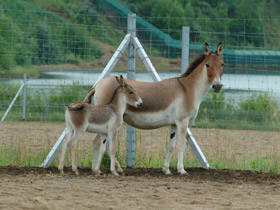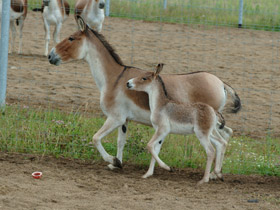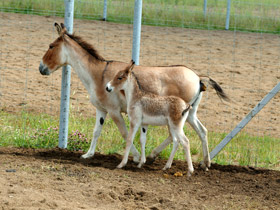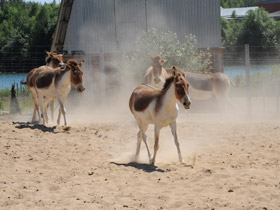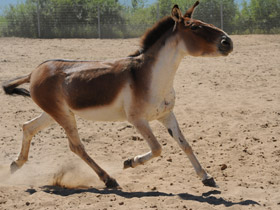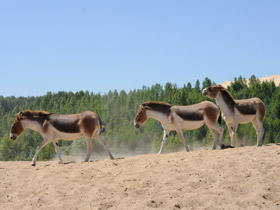The kiang (Equus kiang)
The kiang (Equus kiang) is the largest of the Asinus subgenus. It is native to the Tibetan Plateau in Ladakh, northern Pakistan, Tajikistan, China and northern Nepal. It inhabits montane grasslands and shrublands. Other common names for this species include Tibetan wild ass, khyang and gorkhar.
Appearance and habitat
Equus kiang is a species of perissodactyl mammal of the family Equidae endemic to the Tibetan plateau. It was formerly considered a subspecies of Equus hemionus.
Equus kiang is the largest of the asses and the second largest of the wild asses: it weighs between 300 and 400 kg with a body length of about 2 metres and a height at the withers of up to 140 cm. Its ears are longer than those of horses, but shorter than those of domestic donkeys; its mane is short and erect, and its tail has a long brush of hair at the end. Equus kiang inhabit the entire Tibetan range of mountain ranges and plateaus north of the Himalayas. Their habitat is dry steppes up to 5000 m altitude.
Distribution
Kiangs are found on the Tibetan Plateau, between the Himalayas in the south and the Kunlun Mountains in the north. This restricts them almost entirely to China, but numbers up to 2500 to 3000 are found across the borders in the Ladakh, Himachal Pradesh, and Uttarakhand regions of India, and smaller numbers along the northern frontier of Nepal.
Three subspecies of kiangs are currently recognised:
- Equus kiang kiang — western kiang (Tibet, Ladakh, southwestern Xinjiang);
- Equus kiang holdereri — eastern kiang (Qinghai, southeastern Xinjiang);
- Equus kiang polyodon — southern kiang (southern Tibet, Nepalese border).
The eastern kiang is the largest subspecies; the southern kiang is the smallest. The western kiang is slightly smaller than the eastern and also has a darker coat. However, no genetic information confirms the validity of the three subspecies, which may simply represent a cline, with gradual variation between the three forms.
Kiangs inhabit alpine meadows and steppe country between 2,700 and 5,300 m (8,900 and 17,400 ft) elevation. They prefer relatively flat plateaus, wide valleys, and low hills, dominated by grasses, sedges, and smaller amounts of other low-lying vegetation. This open terrain, in addition to supplying them with suitable forage absent in the more arid regions of central Asia, may make it easier for them to detect, and flee from, predators.
Social behaviour and reproduction
Equus kiang live in groups of between 5 and 400 individuals, the largest of which consists of females, foals and young of both sexes. The leader is usually an experienced adult female. Social bonds are very strong in Equus kiang; they know all members of their group by sight and always stick together. Males are usually solitary in summer and gather in bachelor groups in winter. In search of food, Equus kiang travel long distances across rivers and other bodies of water. They are good swimmers and are noted for their speed and indefatigability. In summer, males begin to follow groups of females and compete with their rivals for the right to appear. After a gestation period of about a year, the female gives birth to a foal, which can follow its mother a few hours after birth. At one year of age, the foals become independent.
Like all equids, kiangs are herbivores and feed on grasses and sedges, especially Stipa, but also on other local plants such as marsh sedges, true sedges and meadow grasses. When little grass is available, such as during winter or in the more arid margins of their native habitat, they have been observed eating shrubs, grasses and even Oxytropis roots, dug into the ground. Although they sometimes drink at waterholes, such water sources are scarce on the Tibetan plateau, and it is likely that they obtain most of their water from the plants they eat, or possibly from snow in winter.
Their only real predator, apart from humans, is the Himalayan wolf. Kiangs defend themselves by forming a circle and, with their heads down, kick violently. As a result, wolves often attack isolated animals that have wandered away from the group. Kiangs sometimes gather in large packs, which can number up to several hundred individuals. However, these are not permanent but temporary groupings, consisting only of young males or mothers and their foals. Older males are usually solitary, defending a territory of 0.5-5 km2 against rivals and dominating local groups of females. Territorial males sometimes become aggressive towards intruders, kicking and biting them, but more commonly chase them away after a threatening display of ear-smashing and braying.
Conservation status
Equus kiang has always been hunted for its meat and skin by local people. Today, Equus kiang are rare and these beautiful ungulates can only be seen in a few zoos around the world, including Moscow, Riga, Beijing, Berlin and San Diego.









